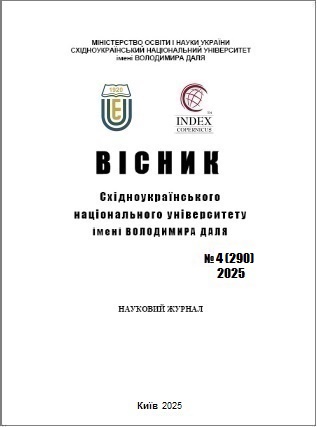Еconomic aspects of the use of secondary resources and materials in the context of circular energy
DOI:
https://doi.org/10.33216/1998-7927-2025-290-4-90-97Keywords:
circular energy, sustainable development, economic aspects, energy efficiency, business modelsAbstract
The use of secondary resources in the formation of sustainable energy systems is important for the development of a modern economy, as it contributes to reducing dependence on fossil energy sources, reducing environmental pollution and optimizing resource use. The growing demand for energy and depletion of natural resources make circular approaches to energy a necessity, and the use of waste as an efficient energy carrier and the integration of innovative technologies turn secondary resources into a key element of sustainable development. Modern trends in closed energy systems are focused on the digitalization of energy flow management, the use of artificial intelligence to increase the efficiency of processing secondary resources. An example is the G7 countries that invest in innovative energy-efficient technologies and optimize logistics chains to reduce waste. The Circular Energy concept focuses on the maximum reduction of waste and processing, repurposing and recycling technologies in energy systems, emphasizing the importance of sustainable development. Additionally, effective management of secondary resources allows to significantly reduce greenhouse gas emissions, reduce the burden on natural ecosystems and increase the level of energy independence of countries.
Stimulation of this sector includes tax breaks, subsidies and environmental regulations that contribute to the economic efficiency of the industry. Also, governments and international organizations are developing new regulatory mechanisms aimed at expanding the possibilities of using secondary resources and improving their processing technologies. In particular, investments in research and development contribute to the creation of new materials with improved energy characteristics that can effectively replace traditional fossil resources.
The above aspects emphasize the impact of secondary resources on the formation of sustainable economic models, reducing production costs and increasing energy efficiency in modern industry. The use of circular principles in energy is a key factor in achieving climate goals and ensuring long-term environmental sustainability.
References
1. Zupančič, M., Možic, V., Može, M., Cimerman, F., & Golobič, I. Current status and review of waste-to-biogas conversion for selected European countries and worldwide // Sustainability. 2022. Vol. 14, No. 3. P. 1823. DOI: 10.3390/su14031823.
2. World cities report: The value of sustainable urbanization [Електронний ресурс]. – 2020. – Режим доступу: https://unhabitat.org/sites/default/ files/2020/10/wcr_2020_report.pdf.
3. Long, A., & Ascent, D. World Economic Outlook. – International Monetary Fund, 2020.
4. Le Quéré, C., Jackson, R. B., Jones, M. W., Smith, A. J., Abernethy, S., Andrew, R. M., De-Gol, A. J., Willis, D. R., Shan, Y., Canadell, J. G., & Friedlingstein, P. Temporary reduction in daily global CO2 emissions during the COVID-19 forced confinement // Nat. Climate Change. 2020. Vol. 10, No. 7. P. 647–653.
5. Sharif, A., Saqib, N., Dong, K., & Khan, S. A. R. Nexus between green technology innovation, green financing, and CO2 emissions in the G7 countries: the moderating role of social globalization // Sustainable Development. 2022. Vol. 30, No. 6. P. 1934-1946.
6. Afshan, S., Ozturk, I., & Yaqoob, T. Facilitating renewable energy transition, ecological innovations and stringent environmental policies to improve ecological sustainability: evidence from MM-QR method // Renewable Energy. 2022. Vol. 196, No. 1. P. 151-160.
7. Sarfraz, M. et al. The relationship between firms’ financial performance and performance measures of circular economy sustainability: an investigation of the G7 countries // Economic Research-Ekonomska Istraživanja. 2023. Vol. 36, No. 1. P. 2545-2572.
8. Sustainability Satelites [Електронний ресурс]. – Режим доступу: https://energy.sustainability-directory.com/area/circular-energy/.
9. Shopeju, O. Optimization of recycling processes for industrial metal waste (Bachelor's thesis, Savonia University of Applied Sciences) // Theseus [Електронний ресурс]. 2024. – Режим доступу: https://www.theseus.fi/bitstream/handle/10024/864572/Shopeju_Olakunle.pdf?sequence=2.
10. Gutowski, T. G., Sahni, S., Allwood, J. M., Ashby, M. F., & Worrell, E. The energy required to produce materials: Constraints on energy-intensity improvements, parameters of demand // Philos. Trans. R. Soc. A Math. Phys. Eng. Sci. 2013. Vol. 371. DOI: 10.1098/rsta.2012.0003.
11. Graedel, T. E., Allwood, J., Birat, J. P., Buchert, M., Hagelüken, C., & Reck, B. K. What do we know about metal recycling rates? // J. Ind. Ecol. 2011. Vol. 15. P. 355–66. DOI: 10.1111/j.1530-9290.2011.00342.x.
12. Graedel, T. E., Harper, E. M., Nassar, N. T., & Reck, B. K. On the materials basis of modern society // Proc. Natl. Acad. Sci. U. S. A. 2015. DOI: 10.1073/pnas.1312752110.
13. Reck, B. K., & Graedel, T. E. Challenges in metal recycling // Science (80-). 2012. Vol. 337. P. 690–5. DOI: 10.1126/science.1217501.
14. Dahmus, J. B., & Gutowski, T. G. What gets recycled: An information theory based model for product recycling // Environ. Sci. Technol. 2007. Vol. 41. P. 7543–50. DOI: 10.1021/es062254b.
15. Schlesinger, M. The Recycling Industry // Alum. Recycl. 2006. P. 163–70. DOI: 10.1201/9781420006247.ch11.
16. Schlesinger, M. E. Aluminum recycling: Second edition. 2013. DOI: 10.1201/b16192.
17. Wellenreuther, F., Detzel, A., Krüger, M., & Busch, M. Aktualisierte Ökobilanz von Grafik- und Hygienepapier: Spotlight Report / за участі Früh, S., Wagener, R., Grünwasser, S., Wolf, F., Schönheit, E., & Trauth, J. – Heidelberg: ifeu, 2022. – Umweltbundesamt.
18. European Environment Agency (EEA). Investments into the Sustainability Transition [Електронний ресурс]. 2024. – Режим доступу: https://www.eea.europa.eu/publications/investments-into-the-sustainability-transition.
19. Inui, T. Protecting the global environment: Initiatives by Japanese business. – World Bank Publications, 2002.
20. Bian, J. S., & Zhao, X. Tax or subsidy? An analysis of environmental policies in supply chains with retail competition // European Journal of Operational Research. 2020. Vol. 283. P. 901-914. DOI: 10.1016/j.ejor.2020.01.038.
21. Swallow, T. Ellen MacArthur Foundation’s Influence on Circular Economy // Sustainability. 2024. February 19.
22. Closed Loop Partners. Closed Loop Partners doubles down on investment in Earthodic, advancing coating alternatives for paper packaging // PR Newswire [Електронний ресурс]. 2024. – Режим доступу: https://www.prnewswire.com/news-releases/closed-loop-partners-doubles-down-on-investment-in-earthodic-advancing-coating-alternatives-for-paper-packaging-302303546.html.
23. Yi, Y., Wang, Y., Fu, C., & Li, Y. Taxes or subsidies to promote investment in green technologies for a supply chain considering consumer preferences for green products // Computers & Industrial Engineering. 2022. Vol. 165. P. 108371. DOI: 10.1016/j.cie.2022.108371.

